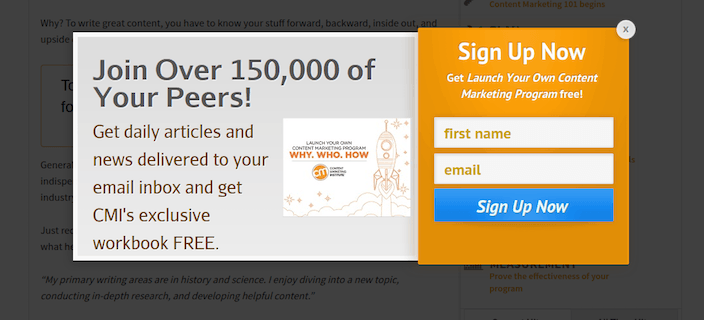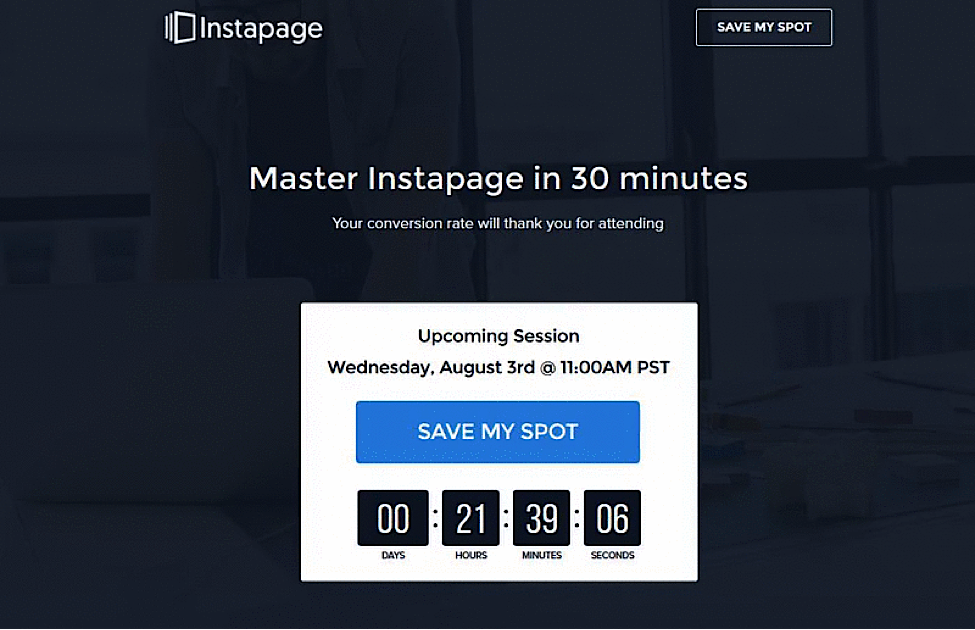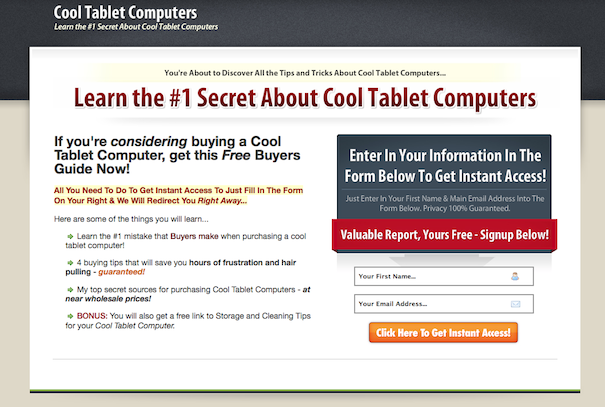How would you like to add some more recipients to your email list?
If so, then you need a fantastic squeeze page.
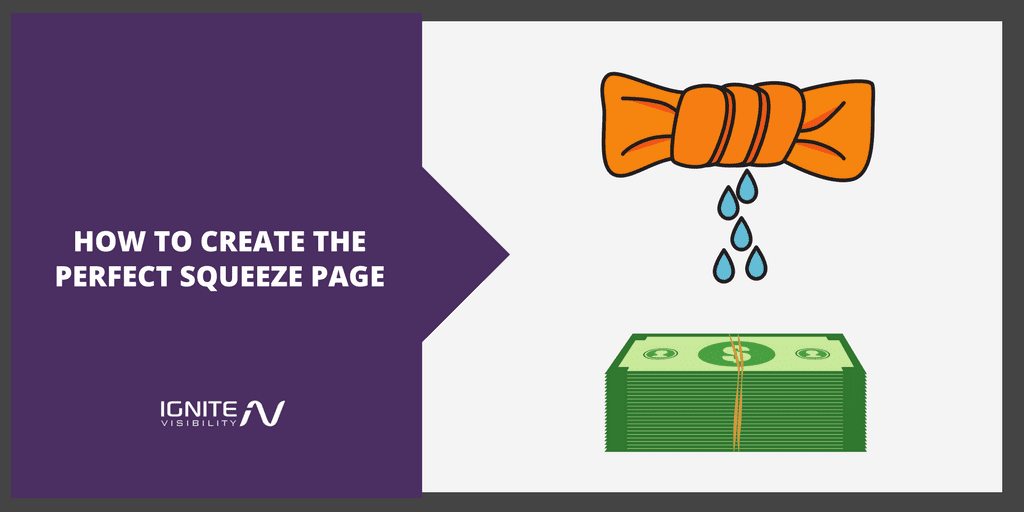
If you haven’t heard the term “squeeze page” before, it’s a landing page that’s designed to capture email addresses from people in your target market. Usually, the page “tempts” people to volunteer their closely guarded email addresses by offering them something free in exchange.
That’s why they’re called squeeze pages. They “squeeze” an email address out of visitors.
It’s important to grow your email list for a number of reasons:
- Emails are 6x more likely to get a click-through than a tweet
- Emails are 40x better than social media for customer acquisition
- Emails have the highest conversion rate (66%) when compared to other marketing messages
In this article, we’ll go over what you need to do to design a great squeeze page so that you can improve your email marketing reach.
What Will Your Squeeze Page Offer?
Before you even design your squeeze page format (which we’ll cover shortly), you first need to determine what you’re going to offer people in exchange for an email address.
The first thing you want to think about is the cost. You can probably get a lot of sign-ups if you offer everybody a free digital camera but that’s not practical.
On the other hand, if you’ve run the numbers and determined that each email signup is worth $50 in net profit on average, then anything that’s less than $50 in cost will generate a positive return. It will give you an even better return if you’ve got a strategy in place to capture some repeat business from existing customers.
Of course, the best offer is one that doesn’t cost you anything. A lot of businesses give away freebies that are free for them as well.
How do they do that? Usually, they offer an e-book that’s packed with valuable info for people in their target market.
That e-book is often written by the business owner or one of the partners. So it doesn’t cost anything (except time).
For example, if you’re running a digital marketing business, you might tempt people with an e-book entitled “10 SEO Tricks That Top Agencies Don’t Want You to Know.” That’s got a nice clickbait title and appeals to people who need help with online marketing.
Once you’ve written your e-book, use the squeeze page to tell visitors that you’ll email it to them. That’s how you’ll snag the email address.
That brings up another important point. If you’re asking people for an email address, you should offer a freebie that requires an email address.
In other words, don’t ask for an email address in exchange for a link to a YouTube video. Savvy people will smell that trap a mile away and you’ll generate ill will.
In addition to an e-book, here are a few other offers that require an email address:
- An email course
- A white paper collection
- Personalized service plans
- Templates
Getting Started With the Squeeze Page
Once you’ve determined what you want to offer, it’s time to set up a squeeze page. But what’s the best way to do that?
You can do it yourself. It will cost money but you’ll have the advantage of a squeeze page that’s completely customized to your own business model.
Alternatively, you could use a squeeze page generator. There are plenty of them on the market.
The downside to some of those services is that they might box you in to a monthly subscription fee. Also, you may not get the flexibility that you need for your marketing efforts.
If you’re using WordPress, then your best bet might be to go with one of the WordPress squeeze page builders. Again, there’s no shortage of them.
The advantage with a WordPress plugin is that you can update your squeeze page from the same administrative console that you use to create posts and handle design updates.
Once you’ve decided how you’d like to create your squeeze page, it’s time to decide the format you’d like to use.
Pop-Up Squeeze Pages
By now, you’ve probably seen countless pop-up squeeze pages. In fact, if you click on those links just above, you’re likely to see some.
But just because they’re popular, that doesn’t mean they’re welcome. As a rule of thumb, website visitors hate pop-ups.
Why? Because they’re inherently disruptive. They prevent people from reading the content that brought them to the website in the first place.
In fact, interruptive pop-ups are hated even more than videos that autoplay.
That’s why some digital marketers go with exit-intent pop-ups. Those are the pop-ups that don’t appear until the visitor tries to leave the website.
Modern-day websites can detect when a visitor points the mouse cursor in the URL bar, over another tab, or over the back button. When that happens, they can display a pop-up.
Those kinds of pop-ups are much less intrusive. Also, people don’t need to click off of them to continue doing whatever they were doing. Exit-intent pop-ups don’t block people from visiting another site.
If you do decide to use a pop-up, an exit-intent pop-up is probably your best bet. You won’t irritate the people that you’re trying to reach.
Splash Pages vs Squeeze Pages
Another type of squeeze page is a splash page. It’s a page that visitors are forwarded to when they first visit your website.
If you want to see a splash page in action, just go to Forbes.com right now (assuming you haven’t visited that site already today). You’ll see the website splash page.
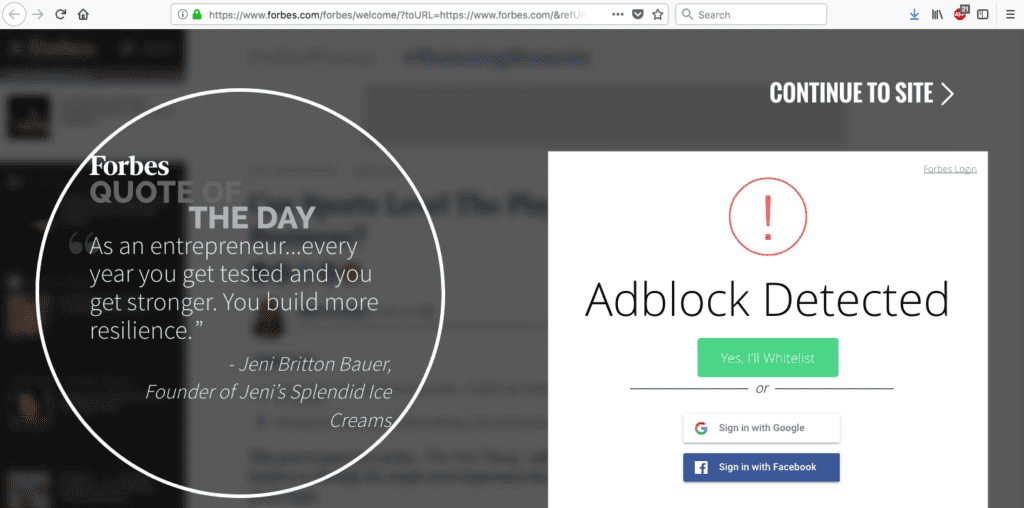
On that splash page, you have the option to continue to the site right away. In the past, Forbes forced people to wait a few seconds before they could go to the site, but the company must have received a lot of negative feedback about that.
If you don’t do anything and just wait a little while, the splash page will forward you to the URL you were going to. In this case, that’s the home page.
You’ll get that splash page just once a day. However, if somebody emails you a link to a Forbes article tomorrow, you’ll see the splash page again if you click the link.
The trick to using your own splash page to capture email addresses is to make sure that people only see it once. You don’t want to do what Forbes does and show it to people every day.
You could get away with showing it once a month. That’s not too user-hostile and might give you a second chance to reach people who got away the first time.
Also, make it abundantly clear how people can get away from the splash page to view the content they’re looking for. Put a big, fat button on the page that reads: “Continue to Site” or words to that effect.
Remember: some people don’t want to volunteer an email address. Don’t make your site hostile to them or you’ll just irritate the people you’re trying to reach.
The Headline for Your Squeeze Page
For many squeeze pages, it’s best to display a prominent headline that tempts the visitor to read more. Make sure you follow great principles of successful copywriting headlines.
For example, consider the title of the e-book that we looked at above: “10 SEO Tricks That Top Agencies Don’t Want You to Know.” That title promises to let people in on a secret (10 secrets to be exact). It tempts people to learn more so they can share uncommon knowledge.
Come up with a headline that will 1) appeal to people in your target market and 2) promote your freebie.
Pro-tip: feel free to consult older books on successful copywriting to get great ideas. You’ll find that some of the copywriting strategies from decades ago will work just as well today because human nature hasn’t changed.
Social Proof Will Increase Sign-ups on Your Squeeze Page
You should also add social proof to your website. That’s a great way to crowdsource your marketing efforts.
One of the best types of social proof is testimony from satisfied customers. That’s because the people you’re trying to reach are potential customers, so they’ll be interested in learning about what actual customers think.
In this case, you’d want to offer testimonies from people who’ve read your e-book (or whatever you’re offering for free) and loved it. That will further incentivize them to volunteer an email address.
For example, add a quote like this: “This e-book showed me everything I was doing wrong in SEO. By following the advice in it, I’ve moved 14 of my pages to the top of the search results!” Be sure to include the name of the person who read it to boost credibility.
If possible, include expert testimonies as well. For example, if you could get an endorsement from Neil Patel for your e-book, you’ll likely get more email addresses.
Scarcity
Another great marketing strategy that drives conversions is scarcity. It’s one of Robert Cialdini’s principles of persuasion.
When you use scarcity, you’re trying to convince people that they’ll miss out if they don’t act immediately.
For example, consider that e-book we’ve been talking about. Let’s say that you’re going to give it away to only the first 100 people who sign up for your email list.
Advertise that in your squeeze page. Put it in your headline.
For example, change your headline to read: “Available to Only 100 People: 10 SEO Tricks That Top Agencies Don’t Want You to Know.”
Ask your development team to put a counter on the page so that every time somebody signs up, it subtracts 1 from the number of people who are eligible to get the e-book.
Now, you’re adding scarcity to the offer in addition to promising some secret knowledge. That’s increasing the likelihood that people will give you an email address.
Colors Matter on Squeeze Pages
Yes, color matters when designing a squeeze page. Make sure that the colors on your squeeze page align with your marketing goals.
Ideally, the squeeze page color scheme should use the same colors as your website. You’ll turn people off if there’s a harsh contrast between the squeeze page and your normal color scheme.
Also, feel free to use white space. Avoid cramming as much text as possible above the fold because you think it will increase your conversion rate.
Empty space is relaxing to the eye. Busy space is confusing.
Limit Your Squeeze Page’s Form Fills
Once you’ve finally got somebody to look at your squeeze page and say “Sold! I’ll sign up!” you haven’t quite won the battle. You still need to get them to go through the sign-up process.
That’s why you should make that process as easy as possible.
If you add form fields asking for the person’s snail mail address, home phone number, work phone number, cell phone number, and marital status, you’re likely to see a lot of people bail on your squeeze page.
Instead, ask for only the information that you absolutely need.
In many cases, you might just need the email address and nothing else. In some cases, you might want to collect the person’s first name so that you can personalize the emails you send out.
Use a CTA That Emphasizes Value
Undoubtedly, you’ve seen some generic call to action (CTA) buttons. Usually, they’re labeled with some boring text like “Submit,” “OK,” “Yes,” or “Do It.”
Don’t use that kind of text in your CTA button. It doesn’t covey value.
Instead, give your button text that even further tempts people to volunteer an email address.
For example, the text: “I Want to Learn SEO Secrets” conveys value. You’re giving people a reason to click on the button within the text itself.
Another neat trick that a lot of digital marketers are doing these days is using the “No” button to force visitors to admit they’re rejecting a great offer.
For example, the text: “No thanks, my SEO efforts are working perfectly” applies to almost nobody. Yet, it’s the “No” button that visitors would have to click to reject the offer for the free e-book.
Use Stimulating Imagery
If your e-book has a great cover, why not share it with the people you want to read it? That’s a great way to give visitors some reassurance that the book you’re offering really does exist.
Again, imagery also helps with comprehension. People are busy and they don’t have time to read a whole lot of text that’s promoting your freebie. Use a picture that’s worth a thousand words.
Auto-Responder
Once people do sign up for your email list, your auto-responder should send them the freebie immediately. Otherwise, you’ll develop bad blood between you and a potential customer.
There’s an exception to that rule. If you’re verifying someone’s email just to be sure that he or she really wants to sign up for your email list, you should send out that email immediately. Then, once the verification process is complete, you should send out the freebie.
Wrapping Up Squeeze Pages
A great squeeze page will land you more leads. Then, you can nurture those leads so that they eventually become paying customers.
If you don’t have a squeeze page, then now is the time to develop one. Get some inspiration by looking at outstanding examples and come up with a page that will appeal to people in your market.
